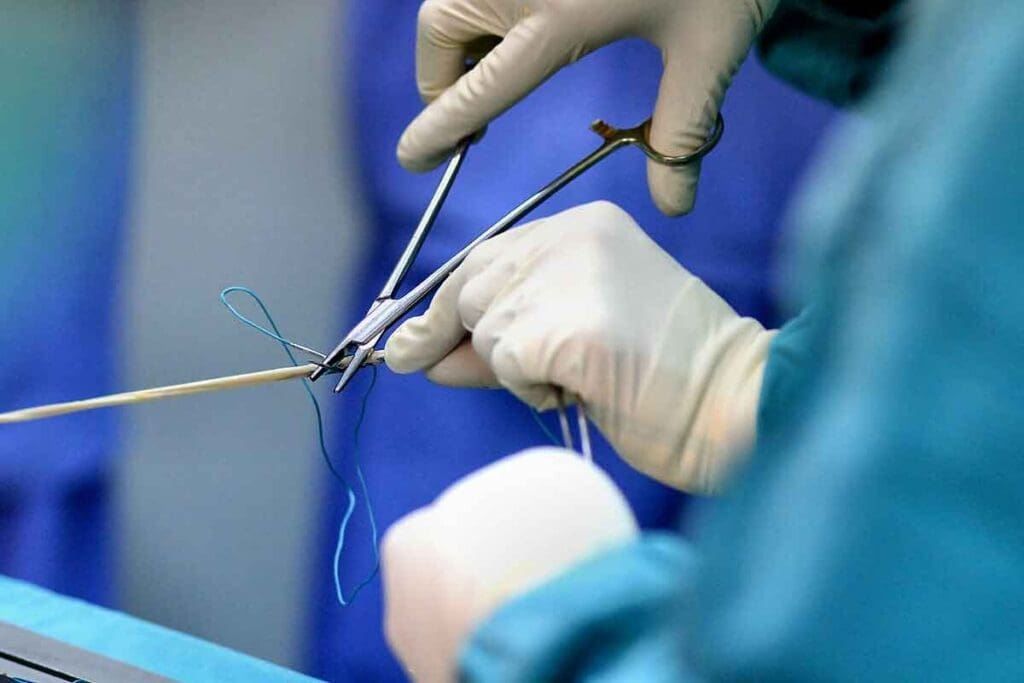Last Updated on November 26, 2025 by Bilal Hasdemir

Thinking about a carotid artery angiogram can be scary. But knowing what to expect can make you feel more in control. At Liv Hospital, we focus on keeping you safe and making you feel at ease. We use the latest medical methods to care for you.
A carotid angiogram is a way to see the big blood vessels in your neck. These vessels, called carotid arteries, feed your brain. If they get blocked by plaque, it can cause serious problems.
We’ll help you get ready for your angiogram carotid procedure. We want it to be safe and successful for you.
Key Takeaways
- Understand the carotid artery angiogram procedure and its purpose.
- Learn how to prepare for the procedure to ensure a smooth experience.
- Discover what to expect during and after the carotid angiogram.
- Find out how Liv Hospital prioritizes patient safety and trust.
- Understand the importance of carotid artery disease diagnosis and treatment.
Understanding Carotid Artery Angiogram

A carotid artery angiogram is a key test to see the carotid arteries. These arteries carry blood to the brain. It helps doctors find blockages or problems in these arteries, which can cause strokes if not treated.
What is a Carotid Artery Angiogram?
This test uses X-rays to show the carotid arteries. A catheter is put into an artery in the groin. It’s then moved to the carotid arteries under X-ray.
After it’s in place, a dye is injected. This dye makes the arteries visible. Doctors can then see any blockages or narrowing.
Types of Carotid Angiography Techniques
There are different carotid angiography methods. Each has its own benefits and uses. Here are a few:
- Traditional Carotid Angiogram: This method uses a catheter and X-ray imaging to reach the carotid arteries.
- CT Angiography: This uses CT scans to create detailed images. It’s less invasive and gives a lot of information about the arteries.
- MR Angiography: This method uses magnetic fields and radio waves. It creates detailed images without X-rays or dye.
| Technique | Invasiveness | Imaging Method | Contrast Dye |
| Traditional Carotid Angiogram | Invasive | X-ray | Yes |
| CT Angiography | Minimally Invasive | CT Scan | Yes |
| MR Angiography | Non-Invasive | MRI | No |
Why Your Doctor Might Recommend This Procedure
If you have symptoms like TIAs or stroke, your doctor might suggest this test. It helps doctors see how bad any blockages are. This guides treatment to prevent future strokes.
Doctors usually recommend this test after other tests show problems. It gives detailed images of the arteries. This helps doctors create a treatment plan just for you.
Traditional vs. CT Angiography: Preparation Differences

It’s important to know the differences between traditional and CT angiography for a carotid angiogram. Both methods help see the carotid arteries, but they are different. They need different preparations.
Catheter-Based Carotid Angiography
Traditional carotid angiography uses a catheter in the leg to reach the carotid arteries. You need to prepare carefully. This includes:
- Fasting before the procedure
- Stopping certain medications
- Having someone drive you home
This method gives detailed images of the carotid arteries. It’s often used when intervention is needed.
CT Angiography of the Carotid Artery
CT angiography of the carotid artery is less invasive. It uses CT scans and contrast to show the carotid arteries clearly. To prepare for a CT angiogram carotid, you should:
- Avoid food and drink before the scan
- Tell your doctor about allergies or kidney issues
- Remove metal objects or jewelry
How Preparation Requirements Differ
The preparation for traditional and CT angiography varies. Traditional angiography is more invasive, needing more checks and care after. On the other hand, CT angiography is quicker and less invasive. It requires less preparation but attention to contrast dye allergies and kidney function.
Knowing these differences helps you prepare for your carotid artery angiogram. Your healthcare provider will guide you based on your needs and the procedure type.
Medical Evaluation Before Your Procedure
Before a carotid artery angiogram, a detailed medical check is key. It makes sure you’re safe and the procedure works well. This step is vital for getting ready for the angiogram.
Required Pre-Procedure Tests
You’ll need to take several tests for your health check. These tests look at your blood and your carotid arteries. You might have:
- Blood tests to check your blood chemistry and count
- Electrocardiogram (ECG) to evaluate your heart’s electrical activity
- Stress test to assess your heart’s function under stress
- Imaging tests such as ultrasound or CT scans to visualize your carotid arteries
| Test | Purpose |
| Blood Tests | Evaluate blood chemistry and count |
| Electrocardiogram (ECG) | Assess heart’s electrical activity |
| Stress Test | Evaluate heart function under stress |
Discussing Your Medical History and Allergies
Talking about your medical history and allergies with your doctor is important. This helps your healthcare team:
- Identify any risks from the procedure
- Take steps to lower these risks
- Change the procedure or plan if needed
Tell your doctor about any allergies, like to contrast dye or iodine. These are often used in angiograms.
Medication Review and Adjustments
Your doctor will look at your medications. They might ask you to change or stop some before the procedure. This is to:
- Prevent problems with the contrast dye or other medicines
- Lower the chance of bleeding or other issues
It’s important to follow your doctor’s advice on medication changes. This keeps you safe during the procedure.
Two Weeks Before: Initial Preparation Steps
The journey to a successful carotid angiogram starts two weeks before. You’ll need to make several key adjustments and arrangements. This ensures a smooth process.
Medication Adjustments to Make
Two weeks before your carotid artery angiogram, review and adjust your medications. Some blood thinners, like warfarin, may need to be stopped. This reduces the risk of bleeding during and after the procedure.
Make a list of all your medications, including dosages and how often you take them. Talk to your healthcare provider about these. They will tell you which medications to keep taking, stop, or adjust. It’s a good time to ask about any medication concerns you have.
Lifestyle Modifications to Consider
Along with medication adjustments, making lifestyle changes can help. Quitting smoking is highly recommended. Smoking can harm your vascular health and make the angio carotid procedure more complicated.
Eating healthy and staying hydrated are also important. They help you be in the best shape for the angiogram. Reducing stress through meditation or deep breathing can also help. Being calm and prepared can make a big difference.
Arranging Transportation and Support
It’s important to arrange for someone to drive you to and from the hospital or clinic. You may be sedated or under medication, so driving yourself is not safe. Having a trusted friend or family member with you can offer emotional support and help with immediate needs.
Having a support system for the days after the procedure is also helpful. They can assist with daily tasks or answer any questions you have while you recover.
48 Hours Before Your Carotid Artery Angiogram
As we get closer to your carotid artery angiogram, it’s time to prepare. We’ll talk about what to eat, drink, and pack for the hospital. This will help make your procedure and recovery smooth.
Dietary Restrictions and Fasting Requirements
Your doctor will tell you what to eat or drink before the test. It’s important to follow these rules to stay safe and get the best results. You might need to stop eating or drinking for a while before the test.
Clear liquids might be okay up to a certain time before the test, but check with your doctor. Try to eat light meals and avoid heavy foods in the 24 hours before. If you have diabetes or other health issues, talk to your doctor about your diet.
Hydration Guidelines
Drinking water is key, but listen to your doctor about how much. Drink plenty of water unless they tell you not to. Staying hydrated helps your body recover and makes sure the dye used in the test is removed well.
Final Medication Adjustments
Two days before your test, check your medications with your doctor. Some medicines, like blood thinners, might need to be changed or stopped. It’s very important to follow your doctor’s advice on medications to avoid problems during or after the test.
Tell your doctor about all the medicines you take, including over-the-counter ones and supplements. This helps your doctor plan your medication before the test.
What to Pack for the Hospital
Having a bag ready with essentials can make your hospital stay better. Pack comfy clothes, personal care items, and important papers like insurance cards. Bring a list of your medications and any medical history to give to your healthcare team.
Having a friend or family member with you at the hospital is a good idea. They can support you and help remember any instructions from your healthcare team.
The Day Before: Final Preparations
As we get closer to your carotid artery angiogram, it’s key to focus on final preparations. We’ll guide you through the steps to make sure you’re ready and confident.
Personal Hygiene Instructions
Good personal hygiene is important before your procedure. Take a shower or bath with antibacterial soap to lower infection risk. Make sure to clean the groin area well, as it’s where the catheter goes in. Be clean and dry, and don’t use lotions or creams after your bath.
Confirming Your Appointment Details
Confirming your appointment with your healthcare provider is a must. Check the time, date, and location of your procedure. Also, see if there are any special instructions or needs. Checking these details can help reduce stress.
Mental Preparation and Anxiety Management
Medical procedures can be stressful. To calm your nerves, try deep breathing or meditation. Imagine a positive outcome to help. If you’re really worried, talk to your doctor. They can offer support or suggest professional help.
Last-Minute Checklist
Here’s a checklist to make sure you’re ready:
- Confirm your appointment details
- Review and pack any necessary documents or items for the hospital
- Follow any dietary restrictions or fasting requirements
- Take any prescribed medications as directed by your doctor
- Arrange for someone to accompany you to the hospital and drive you home
By using this checklist, you’ll be all set for your carotid artery angiogram procedure.
What Happens During a Carotid Artery Angiogram Procedure
Understanding what happens during a carotid artery angiogram can make you feel less anxious. It’s important to know what to expect. This knowledge helps you feel more at ease during the procedure.
Pre-Procedure Preparation in the Hospital
When you arrive at the hospital, our team will help you get ready. Getting ready for the procedure is key for a successful carotid angiogram. You’ll change into a hospital gown and might get an IV line for medication.
Our team will check your medical history and talk about any allergies. They will also explain the carotid artery angiogram procedure in detail. This is your chance to ask any questions.
Step-by-Step Breakdown of the Procedure
The carotid artery angiogram procedure has several steps:
- The area where the catheter will be inserted, typically the groin, is cleaned and numbed with a local anesthetic.
- A small incision is made, and a catheter is carefully inserted into the artery.
- Using X-ray imaging, the catheter is guided to the carotid arteries.
- Contrast dye is injected to visualize the carotid arteries on the X-ray images.
- Images are taken to identify any blockages or abnormalities.
- The catheter is then removed, and pressure is applied to the insertion site to prevent bleeding.
What You Will Feel During the Procedure
You might feel a pinch when the local anesthetic is given. After that, you should not feel pain. You might feel the catheter moving inside your artery, but it’s not painful.
It’s important to stay very quiet during the procedure. Our team will be with you, making sure you’re comfortable and the carotid angio is going well.
Potential Risks and Complications to Be Aware Of
A carotid artery angiogram is usually safe. But, there are risks and complications to know about. Knowing these can help you prepare and know when to get help.
Common Side Effects
Most people don’t have big problems after this test. But, some might feel:
- Mild discomfort or pain at the catheter site
- Bruising or swelling at the site
- A temporary lump or hematoma
- Allergic reactions to the contrast dye, such as rash or itching
These issues are usually short-lived. But, it’s important to watch them and tell your doctor if you’re worried.
Serious Complications to Watch For
Even though rare, serious problems can happen. These might include:
- Stroke or transient ischemic attack (TIA)
- Severe allergic reactions to the contrast dye
- Bleeding or hematoma at the catheter site that doesn’t resolve
- Infection at the catheter site
- Damage to the blood vessels or nerves
Knowing about these risks is key. If you have severe symptoms, get help right away.
Risk Factors That Increase Complication Chances
Some things can make complications more likely. These include:
| Risk Factor | Description |
| Age | Older patients may have a higher risk of complications |
| Pre-existing medical conditions | Conditions such as diabetes, kidney disease, or heart disease can increase risk |
| History of allergic reactions | Previous allergic reactions to contrast dye or other substances |
| Blood clotting disorders | Conditions that affect blood clotting can increase the risk of bleeding |
When to Seek Immediate Medical Attention
If you have these symptoms after the test, get help fast:
- Severe headache or confusion
- Weakness or numbness in the face, arm, or leg
- Difficulty speaking or understanding speech
- Severe pain or swelling at the catheter site
- Signs of infection, such as fever or redness at the site
Knowing about risks can help you be ready. If you’re worried or have questions, talk to your doctor.
Conclusion: Recovery and Follow-Up Care
After a carotid artery angiogram, it’s key to follow certain steps for recovery and care. This ensures a smooth and best outcome. We’ll show you what to do next.
Right after the angiogram, you’ll be watched for a few hours for any issues. You might see some bruising or feel discomfort where the catheter was. But, this usually goes away in a few days. Our team will give you clear instructions on what to do next, including any medicines and when to come back for more checks.
Going to all your follow-up appointments is very important. Your doctor will check how you’re doing and talk about any worries. They’ll also look at the angiogram results and suggest more treatment if needed.
By following our advice on recovery and care after the angiogram, you can lower risks and get the best results. If you have any questions or worries, please contact our team. We’re here to help.
FAQ
What is a carotid artery angiogram?
A carotid artery angiogram is a test that uses X-rays and dye to see the carotid arteries. These arteries carry blood to the brain.
Why is a carotid artery angiogram performed?
Doctors use it to find and check carotid artery disease. This disease can lead to stroke or brain problems.
What are the different types of carotid angiography techniques?
There are two main types. One is traditional catheter-based carotid angiography. The other is CT angiography.
How do I prepare for a carotid artery angiogram?
Your doctor will give you specific instructions. You might need to stop certain medicines, fast, and get a ride home.
What are the risks and complications associated with a carotid artery angiogram?
Risks include allergic reactions to dye, bleeding, and stroke. These are serious complications.
What happens during a carotid artery angiogram procedure?
A catheter is put in your leg and moved to your carotid arteries. Then, dye is injected and X-rays are taken.
How long does it take to recover from a carotid artery angiogram?
Recovery is quick. Most people can go back to normal activities in a day or two.
What are the benefits of CT angiography compared to traditional carotid angiography?
CT angiography is safer and less invasive. It doesn’t need a catheter in an artery.
Can I undergo a carotid artery angiogram if I have kidney disease?
If you have kidney disease, talk to your doctor first. The dye might harm your kidneys.
How do I care for myself after a carotid artery angiogram?
Follow your doctor’s care instructions. This includes watching the catheter site and managing pain.
What should I expect during the follow-up care after a carotid artery angiogram?
Your doctor will review the test results. They will discuss treatment and any health conditions you need to manage.
Are there any dietary restrictions after a carotid artery angiogram?
No specific diet is needed. Just eat healthy and drink plenty of water as your doctor advises.
Can I drive myself home after a carotid artery angiogram?
No, it’s best not to drive. The procedure might make you feel tired or uncomfortable. Have someone drive you home.
References
- Centers for Disease Control and Prevention. (2023). Carotid artery disease. Retrieved from https://www.cdc.gov/stroke/types/carotid.htm






